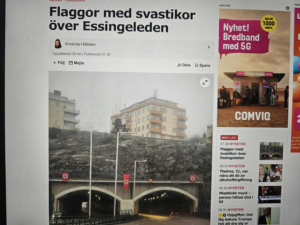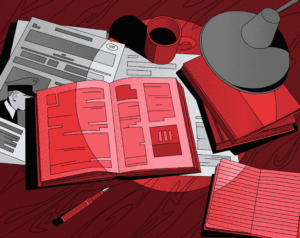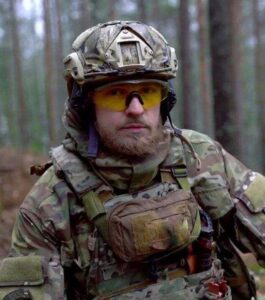By Friedrich Burschel
“The persecution of innocent people was, is, and will always be a despicable act. No words can describe the scope of fascism … I became an antifascist out of a sense of common decency.”
– Marlene Dietrich
The prevailing political trends are currently putting antifascists worldwide under mounting levels of pressure; taking a cue from the Cold War tradition, this politics is increasingly branding antifascism and antifascist activity as an “underestimated danger” and “left-wing extremism”. It is time we countered this ludicrous distortion of the reality of the modern antifascist movement.
The history of antifascism is a history of resistance and defeats; a history of rebellion, even in the face of seemingly hopeless situations – back against the wall, shoulder to shoulder in solidarity with our comrades in a struggle against a monstrous adversary. Antifascism emerged in the wake of the First World War in response to the sweeping triumph of Italian fascism under dictator Benito Mussolini, and other authoritarian regimes throughout Europe during the 1920s and 1930s (for example, Austria in 1933, Lithuania and Greece in 1936, Romania in 1938, Estonia, Latvia and Bulgaria in 1943). In 1932, Mussolini predicted the advent of a “century of fascism”. Antifascism represents an uprising of the people against the sheer unbridled violence unleashed by fascist and quasi-fascist regimes, and by Nazi Germany. Antifascist resistance has often – though not exclusively – been organised by communists. Social democrats, trade unionists, anarchists, undogmatic leftists, and even Christian church groups also carry out antifascist initiatives. The Jewish resistance and the uprisings against the extermination of European Jews during the Second World War can also be seen as part of an antifascist tradition. The use of violence and Military-like structures were often acts of sheer self-defence in the face of mass-murdering regimes, and in particular against the German policy of extermination.
In Weimar Germany, antifascist self-defence groups emerged to combat the violent thugs of Hitler’s National Socialist German Workers’ Party (NSDAP), the Sturmabteilung (SA).
During the Spanish Civil War of 1936–1939, a large number of soldiers from all corners of the world fought on the side of the democratically elected republican Popular Front. The International Brigades supported the fight against the right-wing putschist Francisco Franco and a coalition of clerical-fascist, monarchist groups, big landowners and the Falange, whose military advances against the republican socialist and anarchist resistance were supported by Hitler and Mussolini with planes, weapons and mercenaries.
The Second World War, which was instigated by the German Reich in 1939, was characterised by its wars of extermination – in particular against the Soviet Union and other Eastern European states – by the Shoah, the industrial extermination of European Jews, and the mass extermination of millions more. The murderous German war and policy of occupation throughout Europe and North Africa drove millions of people into resistance; partisan movements and resistance groups arose in all occupied countries, with members seeking to fight the German onslaught by any means possible. From France to Italy, Poland, Yugoslavia and Greece, armed resistance forces rose up against the Germans. The Soviet Union endured the most bloodshed, and its victory over Nazi Germany is generally considered one of the most glorious victories of the Red Army and the front-line partisan units.
The various antifascist underground and partisan units fought alongside Allied regular military units against Hitler’s Germany, with all of them ultimately contributing to the fall of the German Reich, which continued its path of death and destruction until its defeat. The tradition of Antifa, the moniker used by Antifascist Action (AfA) today, is also made up of these kinds of acts of resistance, carried out by smaller, self-organised underground groups of communist, social-democratic, trade unionist, Jewish, church-going and even conservative people, many of whom were rounded up and murdered. At the centre of antifascist commemoration work, however, is the Shoah, the extermination of the European Jews, and the struggle against a global, multifaceted tradition of antisemitism that seems to have survived the German-led break with civilisation relatively unscathed.
The Antifaschistische Aktion (Antifascist Action) emblem was created in 1932 by the Bauhaus designer Max Gebhard. At the time, it consisted of two red flags (symbolising communists and social democrats), waving from left to right, surrounded by a circle with the words “Antifaschistische Aktion”. The emblem that is commonly used all over the world today, and which has undergone countless alterations, with one red (communist) and one black (anarchist) flag waving to the left, is said to have been fashioned by Bernd Langer, an artist from Göttingen, in the 1970s.
During the Cold War, Antifa was considered by many to be a communist and Stalinist political movement. The Association of the Persecutees of the Nazi Regime/Federation of Antifascists (VVN/BdA), an initiative founded in Germany following the war by a number of resistance fighters and Holocaust survivors, is still suspected of harbouring “communist aspirations” and is under surveillance by the domestic secret service. But at the time, the GDR also did not look favourably on the survivors’ self-conception, and the association was dissolved. The Rote Hilfe, which supports antifascists and other activists facing criminal proceedings stemming from political repression, is at the heart of the antifascist tradition.
The history of AfA and Antifa is also one of missteps, including Stalinist dogmatism, sectarianism, misjudgements, male dominance and a militaristic cult of the body that still persists to this day. There are also occasional expressions of uncritical romanticisation of antifascist “heroism”.
The German autonomous movement of the 1980s adopted the antifascist label, and countless groups emerged that called themselves Autonome Antifa (Autonomous Antifa), some of which still exist. Similar groups can be found in other countries.
In particular in Germany, but in many other European countries as well, a new kind of antifascism developed following the collapse of the Eastern Bloc: decidedly antifascist publications and periodicals began to appear, which presented the results of increasingly thorough research and journalism. In Germany alone, there are three specialist journals that focus on antifascism: the Antifaschistische Infoblatt, Der Rechte Rand and the magazine Lotta. In Britain, for example, the magazine Searchlight, the publications of the Never Again Association in Poland, of Expo in Sweden, and the blog Reflexes in France all have an excellent reputation. The standard of this antifascist “counter intelligence” has increased tremendously over the past few decades. The professionalism of the print publications and internet platforms has helped to close the yawning information gap left by the (domestic) secret services, which have managed to infiltrate right-wing scenes via informants and are even implicated in acts of right-wing terror.
Decidedly antifascist forms of political education radically challenge demands for education to be made more “neutral”. According to one maxim, it is imperative that “education after Auschwitz” be antifascist. Meanwhile, the results of a number of antifascist research projects have reached academic standards.
This is especially relevant when it comes to the systematic observation and documentation of court proceedings. Antifascist initiatives were responsible for closely monitoring the National Socialist Underground (NSU) trial (2013–2018) and the trial against the Halle assassin (2020) in Germany, and the trial against the Greek neo-Nazi party Golden Dawn (2015–2020), among others.
The efforts of antifascist groups, historical workshops and educational initiatives, especially in Europe, in commemorating the Holocaust and the German wars of extermination are impressive. Many sites that were impacted by German devastation and Nazi crimes would be forgotten today were it not for the unwavering commitment of antifascists to the remembrance of these atrocities. This work of remembrance is another core aspect of antifascist activism today.
But antifascism has long been more than a mere opponent of neo-Nazism, historical revisionism, neofascist movements and parties, right-wing terror, and the authoritarian maelstrom currently being experienced worldwide. In many cases, the antifascists of today view themselves as being part of neighbourhood work, rent protests, feminist and antiracist struggles, and climate protests. For many people, including the very young, the interrelations between the capitalist bourgeois order that is rapidly moving to the right amid the current crisis and is countering the increasing number of political, social and ecological upheavals with repression and violence are plain to see.
The doctrine of extremism, which emerged in the anticommunist West within the context of the bipolar era of the Cold War, seeks to criminalise left-wing activism against right-wing, reactionary and neofascist politics. It characterises the former as the extremist flip side of violent neo-Nazism and neofascism, describing these two poles as posing the same kind of threat to bourgeois democracy. It is an irony of history that the vilification of the antifascist movement was brought back into fashion by none other than the right-wing authoritarian and populist US President Donald Trump, who called on his fellow citizens to storm the symbols of American democracy. This trend has since been gleefully taken up in numerous other countries, especially in Europe, and draped with the same hackneyed rhetoric stemming from the Cold War. This is even the case in Eastern Europe, where – following a period of real-existing socialism – every incarnation of socialism and every socialist idea is entirely discredited, antifascist activity is presumed to be left-wing extremism, and is in some cases subject to tremendous (secret) police repression.
Antifascism is an emancipatory movement dedicated to solidarity and an unassailable, humane outlook. Today as then, its image is characterised by a sense of humanism, universalism and resistance in solidarity against antihuman ideologies and deeds. This monitoring project is also committed to this self-conception.
Building on this tradition, our monitoring project aims not only to promote a European network of antifascist actors, but also to inform an interested democratic public about hazardous developments not only on the right-wing fringe, but increasingly also in the political centre of our society, and to encourage them to engage in acts of resistance.
See also:
Antifašistički vodič za ljepši svijet. Belgade: Rosa-Luxemburg-Stiftung Southeast Europe,, 2019. https://www.rosalux.rs/bhs/antifasisticki-vodic-za-ljepsi-svijet.
Bray, Mark. Antifa: The Anti-Fascist Handbook. New York: Melville, 2017.
Jour-Fixe-Initiative, ed. Theorie des Faschismus: Kritik der Gesellschaft. Münster: Unrast, 2000.
Traverso, Enzo. “Intellectuals and Anti-Fascism: For a Critical Historization.” New Politics9, no. 4 (2004), https://newpol.org/issue_post/intellectuals-and-anti-fascism-critical-historization/
© Friedrich Burschel, 12.10.2021 [Translated by Hunter Bolin & Louise Pain for Gegensatz Translation Collective]







